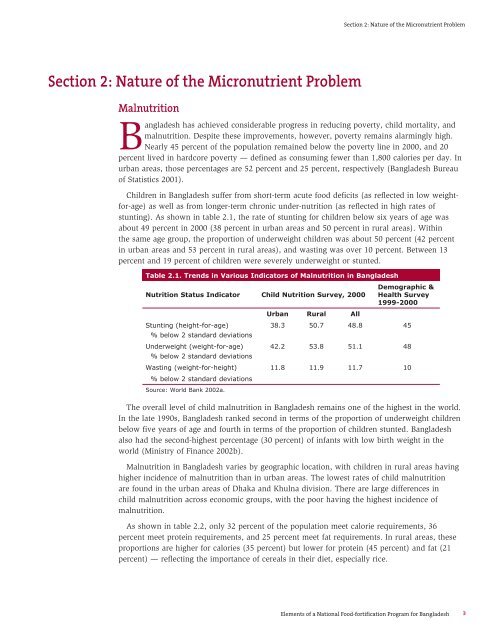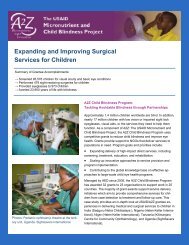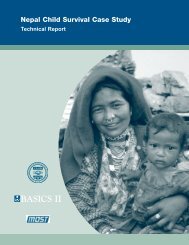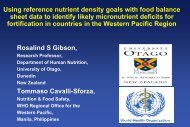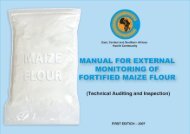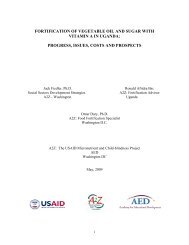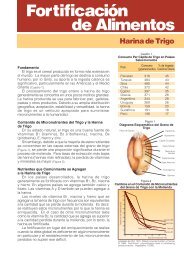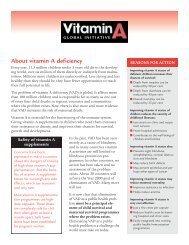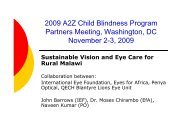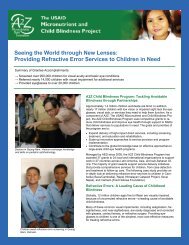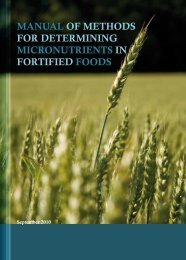Elements of a National Food- Fortification Program for Bangladesh
Elements of a National Food- Fortification Program for Bangladesh
Elements of a National Food- Fortification Program for Bangladesh
Create successful ePaper yourself
Turn your PDF publications into a flip-book with our unique Google optimized e-Paper software.
Section 2: Nature <strong>of</strong> the Micronutrient ProblemSection 2: Nature <strong>of</strong> the Micronutrient ProblemMalnutrition<strong>Bangladesh</strong> has achieved considerable progress in reducing poverty, child mortality, andmalnutrition. Despite these improvements, however, poverty remains alarmingly high.Nearly 45 percent <strong>of</strong> the population remained below the poverty line in 2000, and 20percent lived in hardcore poverty — defined as consuming fewer than 1,800 calories per day. Inurban areas, those percentages are 52 percent and 25 percent, respectively (<strong>Bangladesh</strong> Bureau<strong>of</strong> Statistics 2001).Children in <strong>Bangladesh</strong> suffer from short-term acute food deficits (as reflected in low weight<strong>for</strong>-age)as well as from longer-term chronic under-nutrition (as reflected in high rates <strong>of</strong>stunting). As shown in table 2.1, the rate <strong>of</strong> stunting <strong>for</strong> children below six years <strong>of</strong> age wasabout 49 percent in 2000 (38 percent in urban areas and 50 percent in rural areas). Withinthe same age group, the proportion <strong>of</strong> underweight children was about 50 percent (42 percentin urban areas and 53 percent in rural areas), and wasting was over 10 percent. Between 13percent and 19 percent <strong>of</strong> children were severely underweight or stunted.Table 2.1. Trends in Various Indicators <strong>of</strong> Malnutrition in <strong>Bangladesh</strong>Nutrition Status Indicator Child Nutrition Survey, 2000Demographic &Health Survey1999-2000Urban Rural AllStunting (height-<strong>for</strong>-age)% below 2 standard deviationsUnderweight (weight-<strong>for</strong>-age)% below 2 standard deviationsWasting (weight-<strong>for</strong>-height)% below 2 standard deviationsSource: World Bank 2002a.38.3 50.7 48.8 4542.2 53.8 51.1 4811.8 11.9 11.7 10The overall level <strong>of</strong> child malnutrition in <strong>Bangladesh</strong> remains one <strong>of</strong> the highest in the world.In the late 1990s, <strong>Bangladesh</strong> ranked second in terms <strong>of</strong> the proportion <strong>of</strong> underweight childrenbelow five years <strong>of</strong> age and fourth in terms <strong>of</strong> the proportion <strong>of</strong> children stunted. <strong>Bangladesh</strong>also had the second-highest percentage (30 percent) <strong>of</strong> infants with low birth weight in theworld (Ministry <strong>of</strong> Finance 2002b).Malnutrition in <strong>Bangladesh</strong> varies by geographic location, with children in rural areas havinghigher incidence <strong>of</strong> malnutrition than in urban areas. The lowest rates <strong>of</strong> child malnutritionare found in the urban areas <strong>of</strong> Dhaka and Khulna division. There are large differences inchild malnutrition across economic groups, with the poor having the highest incidence <strong>of</strong>malnutrition.As shown in table 2.2, only 32 percent <strong>of</strong> the population meet calorie requirements, 36percent meet protein requirements, and 25 percent meet fat requirements. In rural areas, theseproportions are higher <strong>for</strong> calories (35 percent) but lower <strong>for</strong> protein (45 percent) and fat (21percent) — reflecting the importance <strong>of</strong> cereals in their diet, especially rice.<strong>Elements</strong> <strong>of</strong> a <strong>National</strong> <strong>Food</strong>-<strong>for</strong>tification <strong>Program</strong> <strong>for</strong> <strong>Bangladesh</strong>3


